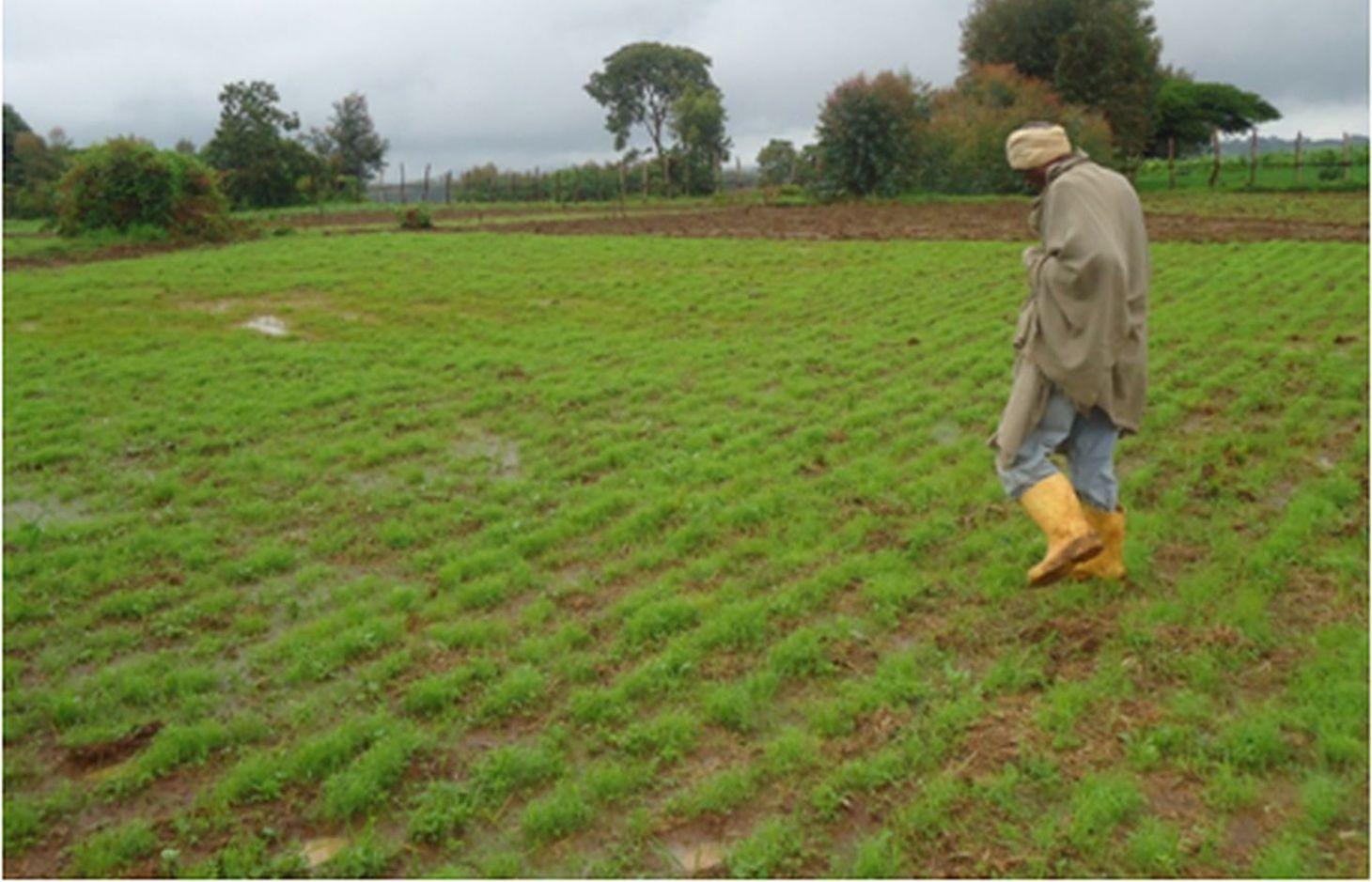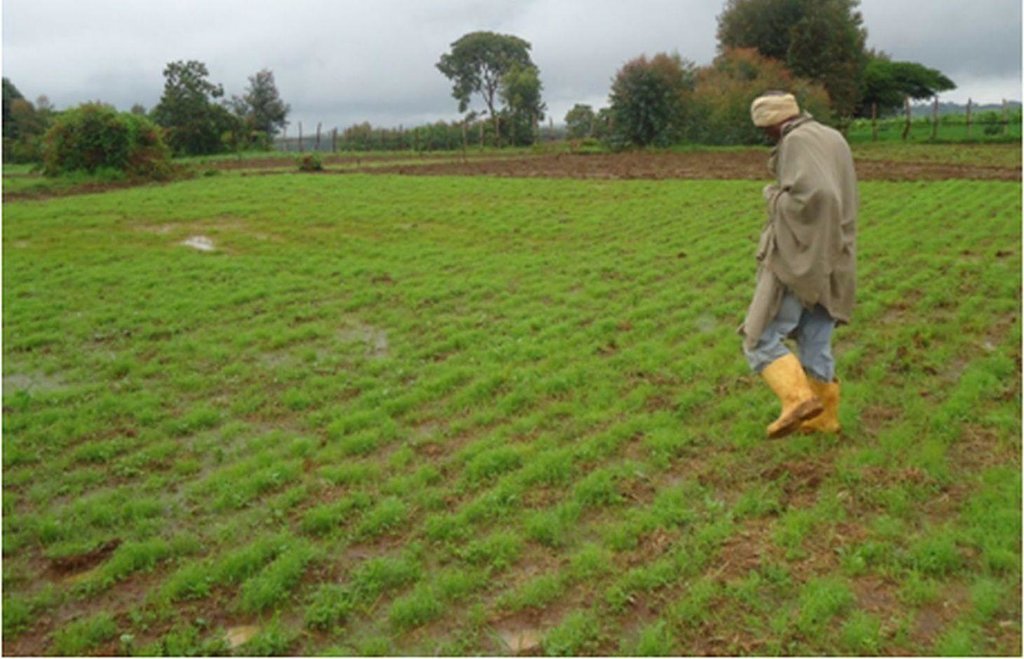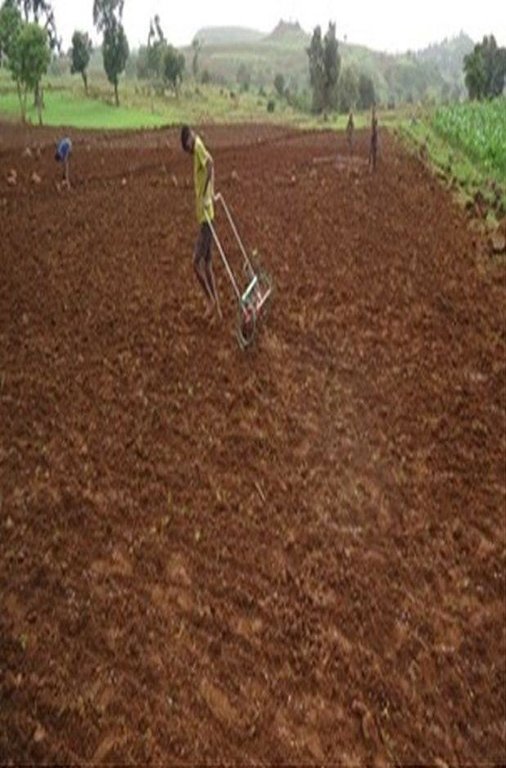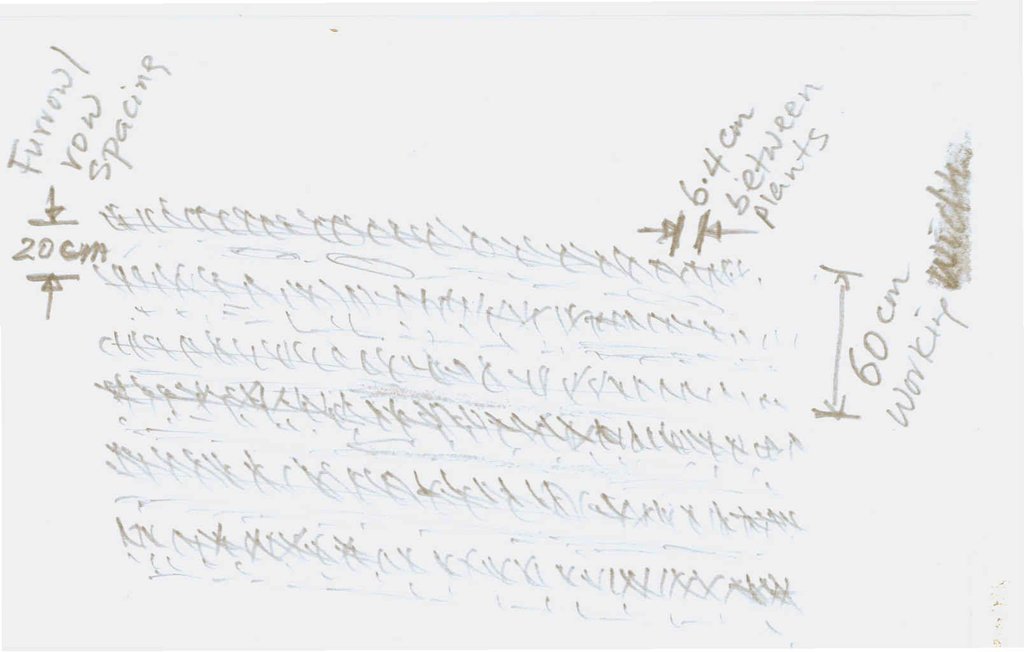Teff row planting [ប្រទេសអេត្យូពី]
- ការបង្កើត៖
- បច្ចុប្បន្នភាព
- អ្នកចងក្រង៖ Gizaw Desta Gessesse
- អ្នកកែសម្រួល៖ –
- អ្នកត្រួតពិនិត្យ Alexandra Gavilano
Teff bemesmr mezrat (Amharic)
technologies_1192 - ប្រទេសអេត្យូពី
ពិនិត្យមើលគ្រប់ផ្នែក
ពង្រីកមើលទាំងអស់ បង្រួមទាំងអស់1. ព័ត៌មានទូទៅ
1.2 ព័ត៌មានលម្អិតពីបុគ្គលសំខាន់ៗ និងស្ថាប័នដែលចូលរួមក្នុងការវាយតម្លៃ និងចងក្រងឯកសារនៃបច្ចេកទេស
អ្នកជំនាញឯកទេស SLM:
Tefferra Abu
251918701086
buteffera@yahoo.com
Bahir Dar Agricultural Mechanization and Food Science Research Centre
ប្រទេសអេត្យូពី
ឈ្មោះអង្គភាពមួយ (ច្រើន) ដែលបានចងក្រងឯកសារ/ វាយតម្លៃបច្ចេកទេស (បើទាក់ទង)
Water and Land Resource Centre (WLRC) - ប្រទេសអេត្យូពី1.3 លក្ខខណ្ឌទាក់ទងទៅនឹងការប្រើប្រាស់ទិន្នន័យដែលបានចងក្រងតាមរយៈ វ៉ូខេត
តើពេលណាដែលទិន្នន័យបានចងក្រង (នៅទីវាល)?
28/01/2014
អ្នកចងក្រង និង(បុគ្គលសំខាន់ៗ)យល់ព្រមទទួលយកនូវលក្ខខណ្ឌនានាទាក់ទងទៅនឹងការប្រើប្រាស់ទិន្នន័យដែលបានចងក្រងតាមរយៈវ៉ូខេត:
បាទ/ចា៎
2. ការពណ៌នាពីបច្ចេកទេស SLM
2.1 ការពណ៌នាដោយសង្ខេបពីបច្ចេកទេស
និយមន័យបច្ចេកទេស:
Teff row planting is an agronomic practice used to place Teff seeds (very small size) in rows of about 20cm apart and at predetermined depth with sufficient cover of firm soil.
2.2 ការពណ៌នាលម្អិតពីបច្ចេកទេស
ការពណ៌នា:
Teff is a staple crop in Ethiopia and used to make 'Injera'. Teff is commonly planted in broadcast technique with a seed rate of 25-30 kg per hectare. This practice results in high competition for nutrient and water, lodging and low productivity (on average 1 ton/ha). Teff row planting is a newly adopted planting method applied for small size seeds of Teff grain. The row planting technique reduces the seed rate from 25kg/ha to 5-8 kg per hectare, ease the weed management, reduce lodging problem, and lessen plant density and then competition for sunlight, nutrient and water. It is practiced on Teff growing soils except on heavy clay soils or Vertisols where it is difficult to prepare defined rows due to the extreme swelling nature of the soil under near saturation moisture condition. However, under optimum soil moisture (45-50%) it is possible to place seeds in row using manual seed drill in black soils with clay texture. The technique is not perfectly working on stony fields. Seed application is possible using locally available plastic bottles with needle size opening to drop seeds, and newly manufactured seed drill pulled by one person.
Purpose of the Technology: The main purpose to practice Teff row planting is to reduce plant density or population per unit area and thereby increase productivity. It also aim to reduce the lodging problem. Additional advantage of row planting for small grain crop, there is some extent of labor reduction for weeding to some extent.
Establishment / maintenance activities and inputs: Teff row planting technique applies on fine seed bed after 3-5 tillage frequency using local ard plough called maresha pulled by pair of oxen. Once the seed bed is finely prepared, first using local adopted application tools like plastic bottles or hand metering the farmer prepares seed rate of 5-8 kg per hectare mixed with proportional sand (approximately seed to sand ratio of 1:3) - it is difficult to manage uniform application and even distribution by applying the seed alone. He applies along the row and step on to cover the seed and compact it. Similarly, fertilizer is applied in the same way. Second option, after the preparation of fine seed bed, seed application is facilitated using drum type manual seed drill (of weight 21 kg) manufactured by Bahir Dar Agricultural Mechanization and Food Science Research Center (BAMFSRC) having 3 rows of 20cm apart, average depth and width of planting furrow equals to 3.6 cm and 6.4 cm and operating at field capacity of 0.06ha/hr. The drill can apply 3-6 kg/ha seed rate and pulled by one person. At tillering stage urea is top dressed. The technique requires 50-60 person days per hectare to apply seed and fertilizer using hand metering/bottles compared to 2-4 person days per hectare using drum type seed drill. Labor requirement for weeding is also reduced by using row planting than broadcast method.
Natural / human environment: Teff grows on wider environment of altitude range 1800-2600 m above sea level. It performs well with annual rainfall of 750-850 mm and temperature of 10-27 degree Celsius. In fact, there are varieties with short growing period adapted under low rainfall conditions. The row planting technique applies commonly on red clay soils having high water holding capacity. The technique potentially applies on slopes ranging from 0-10% with low stone cover.
Teff row planting using manual seed application or hand metering technique can easily be practiced by households having large family labor. Farm households who used the manual seed drill of drum type should have the capacity to afford the seed drill and able to buy fertilizer. Teff is produced for food and market. It has a good price for sale.
Although teff has high market price in country as well as an emerging export market potential, it is produced annually by subsistence farmers. The land holding is small to meet their family food demands. Their wealth condition ranges poor to average characterized with low agricultural advisory, market and water supply services and inadequate infrastructures. Energy supply is relied on biomass energy. Rural education and health services are improved. Rural unemployment and landless populations are at high rates. In general, the well being of the rural people is under poor condition.
2.3 រូបភាពនៃបច្ចេកទេស
2.5 ប្រទេស/តំបន់/ទីតាំងកន្លែង ដែលបច្ចេកទេសត្រូវបានអនុវត្ត និងបានគ្រប់ដណ្តប់ដោយការវាយតម្លៃនេះ
ប្រទេស:
ប្រទេសអេត្យូពី
តំបន់/រដ្ឋ/ខេត្ត:
Amhara
បញ្ជាក់បន្ថែមពីលក្ខណៈនៃទីតាំង:
Bahir Dar Zuria, Mecha, Yilmana Densa, and Dembecha
មតិយោបល់:
Boundary points of the Technology area: 10.630850, 37.506877; 11.274962, 37.226641; 11.355705, 37.426134; 11.649907, 37.500604
2.6 កាលបរិច្ឆេទនៃការអនុវត្ត
ប្រសិនបើមិនច្បាស់ឆ្នាំ សូមបញ្ជាក់កាលបរិច្ឆេទដែលប្រហាក់ប្រហែល:
- តិចជាង 10ឆ្នាំមុន (ថ្មី)
2.7 ការណែនាំពីបច្ចេកទេស
សូមបញ្ជាក់តើបច្ចេកទេសត្រូវបានណែនាំឱ្យអនុវត្តដោយរបៀបណា:
- ពេលកំពុងពិសោធន៍
មតិយោបល់ (ប្រភេទនៃគម្រោង ។ល។):
Teff row planting technique was started in research stations 10 to20 years ago. The technique is extended to large number of farmers' field since 2011 through the scale up program of the Ministry of Agriculture. For instance, in 2013 the Amhara region planned to cover 20-30% of teff growing fields.
3. ចំណាត់ថ្នាក់នៃបច្ចេកទេស SLM
3.2 ប្រភេទដីប្រើប្រាស់មួយប្រភេទ (ច្រើនប្រភេទ) ដែលបានអនុវត្តបច្ចេកទេស

ដីដាំដំណាំ
- ដំណាំប្រចាំឆ្នាំ

ដីសម្រាប់ចិញ្ចឹមសត្វ
- Livestock is grazing on crop residues
មតិយោបល់:
Major land use problems (compiler’s opinion): Major land use problems are soil erosion by water, soil nutrient depletion, gully erosion, steep slope cultivation, land fragmentation, and inappropriate runoff drainage practices like drainage ditches on cultivated fields.
Major land use problems (land users’ perception): Land users commonly specify soil erosion by water, shallow soil depth or soil depletion, low productivity of the soil, scarcity of water, and shortage of grazing land or pasture.
3.3 ព័ត៌មានបន្ថែមអំពីអ្នកប្រើប្រាស់ដី
ការផ្គត់ផ្គង់ទឹកនៅកន្លែងអនុវត្តបច្ចេកទេស:
- ទឹកភ្លៀង និងប្រព័ន្ធស្រោចស្រព
ចំនួនសារដែលដាំដំណាំក្នុងមួយឆ្នាំ:
- 1
សូមបញ្ជាក់:
Longest growing period in days: 180Longest growing period from month to month: July to December
3.5 ការសាយភាយនៃបច្ចេកទេស
បញ្ជាក់ពីការសាយភាយនៃបច្ចេកទេស:
- ត្រូវបានផ្សព្វផ្សាយត្រឹមតំបន់មួយ
ប្រសិនបើបច្ចេកទេសត្រូវបានសាយភាយពាសពេញតំបន់ណាមួយ សូមកំណត់ទំហំផ្ទៃដីអនុវត្តន៍:
- 0.1-1 គម2
មតិយោបល់:
The area covered with Teff row planting referred in this database only considers the area of the pre-scale up activities in the WLRC learning watersheds. The practice is steadily growing over years in teff growing areas of the country in general and Amhara region in particular.
3.6 វិធានការ SLM ដែលបញ្ចូលនូវបច្ចេកទេស

វិធានការក្សេត្រសាស្ត្រ
- A1: ដំណាំ/គម្របដី
មតិយោបល់:
Type of agronomic measures: mineral (inorganic) fertilizers
3.7 កំណត់ប្រភេទនៃការធ្លាក់ចុះគុណភាពដីសំខាន់ៗដែលបច្ចេកទេសនេះបានដោះស្រាយ

ការបាត់បង់រូបសាស្ត្រនៃដី
- Pc: ការហាប់ណែន
- Pk: ការបិទរន្ធដី
មតិយោបល់:
Main causes of degradation: soil management (Teff fields are tilled 4-5 times and heavily trampled/compacted by livestock before sowing)
Secondary causes of degradation: Heavy / extreme rainfall (intensity/amounts) (Heavy rainfall cause high runoff and then erosion. It also create sealing effect on the soil surface)
3.8 ការពារ កាត់បន្ថយ ឬស្តារឡើងវិញនៃការធ្លាក់ចុះគុណភាពដី
បញ្ជាក់ពីគោលដៅរបស់បច្ចេកទេស ដែលផ្តោតទៅការធ្លាក់ចុះគុណភាពដី:
- ការការពារការធ្លាក់ចុះគុណភាពដី
- ការកាត់បន្ថយការធ្លាក់ចុះគុណភាពដី
4. បច្ចេកទេសជាក់លាក់ សកម្មភាពអនុវត្ត ធាតុចូល និងថ្លៃដើម
4.1 គំនូសបច្ចេកទេសនៃបច្ចេកទេសនេះ
4.2 លក្ខណៈពិសេសនៃបច្ចេកទេស/ ពណ៌នាពីគំនូរបច្ចេកទេស
A sketch describing Teff row planting
Location: Aba Gerima, Debre Mewi, Debre Yacob, Gosh Learning. West Gojam/ Amhara Region
Technical knowledge required for field staff / advisors: high (Because of its small seed size, the method requires knowledge of the soil where it performs well and at what depth the seed is placed so that there is high germination and minimizing lodging problem)
Technical knowledge required for land users: high (The land user has to develop capacity and skills on the specific soil and slope conditions where row planting performs well, spacing of rows, depth of furrow and seed quantity per unit area.)
Main technical functions: improvement of surface structure (crusting, sealing), increase of biomass (quantity), Reduction of plant population and competition effect
Secondary technical functions: improvement of topsoil structure (compaction)
Agronomic measure: Row planting
Material/ species: Teff seeds
Quantity/ density: 3-6kg/ha
Remarks: Spacing between rows is 20cm
Mineral (inorganic) fertilizers
Material/ species: Urea and DAP
Quantity/ density: 100 kg/ha
Remarks: for each type of fertilizer
4.3 ព័ត៌មានទូទៅដែលពាក់ព័ន្ធនឹងការគណនាធាតុចូល និងថ្លៃដើម
ផ្សេងៗ/ រូបិយប័ណ្ណជាតិ (បញ្ជាក់):
ETH BIRR
កំណត់អត្រាប្តូរប្រាក់ពីដុល្លាទៅរូបិយប័ណ្ណតំបន់ (បើទាក់ទង)៖ 1 ដុល្លារ =:
20,0
កំណត់ថ្លៃឈ្នួលជាមធ្យមនៃការជួលកម្លាំងពលកម្មក្នុងមួយថ្ងៃ:
3.00
4.4 សកម្មភាពបង្កើត
| សកម្មភាព | ប្រភេទវិធានការ | ពេលវេលា | |
|---|---|---|---|
| 1. | Drum type row teff seeder (with 3 rows) | ការគ្រប់គ្រង |
4.5 ថ្លៃដើម និងធាតុចូលដែលត្រូវការសម្រាប់ការបង្កើតបច្ចេកទេស
| បញ្ជាក់ពីធាតុចូល | ឯកតា | បរិមាណ | ថ្លៃដើមក្នុងមួយឯកតា | ថ្លៃធាតុចូលសរុប | % នៃថ្លៃដើមដែលចំណាយដោយអ្នកប្រើប្រាស់ដី | |
|---|---|---|---|---|---|---|
| សម្ភារៈ | machine use | pc | 1,0 | 71,0 | 71,0 | 100,0 |
| ថ្លៃដើមសរុបក្នុងការបង្កើតបច្ចេកទេស | 71,0 | |||||
4.6 សកម្មភាពថែទាំ
| សកម្មភាព | ប្រភេទវិធានការ | ពេលវេលា/ ភាពញឹកញាប់ | |
|---|---|---|---|
| 1. | Tillage | ក្សេត្រសាស្ត្រ | Annually after onset of rain, 4-5 times |
| 2. | Seeding | ក្សេត្រសាស្ត្រ | After the soil gets sufficient moisture annually |
| 3. | Weeding | ក្សេត្រសាស្ត្រ | 2-3 times per season |
| 4. | Harvesting | ក្សេត្រសាស្ត្រ | Annually at maturity period (Nov-Dec) |
| 5. | Threshing | ក្សេត្រសាស្ត្រ | Annually during slack period (Dce-Jan) |
| 6. | Transporting and storing grain and straw | ក្សេត្រសាស្ត្រ | Annually during slack period |
4.7 កំណត់ថ្លៃដើមសម្រាប់ការថែទាំ/ សកម្មភាពរបស់បច្ចេកទេស (ក្នុងរយៈពេលមួយឆ្នាំ)
| បញ្ជាក់ពីធាតុចូល | ឯកតា | បរិមាណ | ថ្លៃដើមក្នុងមួយឯកតា | ថ្លៃធាតុចូលសរុប | % នៃថ្លៃដើមដែលចំណាយដោយអ្នកប្រើប្រាស់ដី | |
|---|---|---|---|---|---|---|
| កម្លាំងពលកម្ម | labour | 1,0 | 318,0 | 318,0 | 100,0 | |
| សម្ភារៈ | animal traction | 1,0 | 266,0 | 266,0 | 100,0 | |
| សម្ភារៈដាំដុះ | seeds | 1,0 | 4,5 | 4,5 | 100,0 | |
| សម្ភារៈដាំដុះ | fertilizer | 1,0 | 150,0 | 150,0 | 100,0 | |
| ថ្លៃដើមសរុបសម្រាប់ការថែទាំដំណាំតាមបច្ចេកទេស | 738,5 | |||||
មតិយោបល់:
Machinery/ tools: Seed drill, local plough, sickle, hoe
The costs are calculated on hectare basis covered by row planting method. The costs apply for February/March 2014
4.8 កត្តាសំខាន់បំផុតដែលមានឥទ្ធិពលដល់ការចំណាយ
ពណ៌នាពីកត្តាប៉ះពាល់ចម្បងៗទៅលើថ្លៃដើម:
The implementation costs are subject to change due to fluctuation in seasonal labor demand, price of fertilizer, price of iron to construct seed drill, and inflation
5. លក្ខណៈបរិស្ថានធម្មជាតិ និងមនុស្ស
5.1 អាកាសធាតុ
បរិមាណទឹកភ្លៀងប្រចាំឆ្នាំ
- < 250 មម
- 251-500 មម
- 501-750 មម
- 751-1,000 មម
- 1,001-1,500 មម
- 1,501-2,000 មម
- 2,001-3,000 មម
- 3,001-4,000 មម
- > 4,000 មម
តំបន់កសិអាកាសធាតុ
- មានភ្លៀងមធ្យម
- មានភ្លៀងតិចតួច
Thermal climate class: subtropics
5.2 សណ្ឋានដី
ជម្រាលជាមធ្យម:
- រាបស្មើ (0-2%)
- ជម្រាលតិចតួច (3-5%)
- មធ្យម (6-10%)
- ជម្រាលខ្ពស់បន្តិច (11-15%)
- ទីទួល (16-30%)
- ទីទួលចោត (31-60%)
- ទីទួលចោតខ្លាំង (>60%)
ទម្រង់ដី:
- ខ្ពង់រាប
- កំពូលភ្នំ
- ជម្រាលភ្នំ
- ជម្រាលទួល
- ជម្រាលជើងភ្នំ
- បាតជ្រលងភ្នំ
តំបន់តាមរយៈកម្ពស់ :
- 0-100 ម
- 101-500 ម
- 501-1,000 ម
- 1,001-1,500 ម
- 1,501-2,000 ម
- 2,001-2,500 ម
- 2,501-3,000 ម
- 3,001-4,000 ម
- > 4,000 ម
5.3 ដី
ជម្រៅដីជាមធ្យម:
- រាក់ខ្លាំង (0-20 សម)
- រាក់ (21-50 សម)
- មធ្យម (51-80 សម)
- ជ្រៅ (81-120 សម)
- ជ្រៅខ្លាំង (> 120 សម)
វាយនភាពដី (ស្រទាប់លើ):
- មធ្យម (ល្បាយ, ល្បាប់)
- ម៉ត់/ ធ្ងន់ (ឥដ្ឋ)
សារធាតុសរីរាង្គនៅស្រទាប់ដីខាងលើ:
- ខ្ពស់ (>3%)
- មធ្យម (1-3%)
5.4 ទឹកដែលអាចទាញមកប្រើប្រាស់បាន និងគុណភាពទឹក
នីវ៉ូទឹកក្រោមដី:
> 50 ម
ទឹកលើដីដែលអាចទាញយកប្រើប្រាស់បាន:
ល្អ
គុណភាពទឹក (មិនបានធ្វើប្រត្តិកម្ម):
ទឹកសម្រាប់តែការធ្វើកសិកម្ម (ស្រោចស្រព)
5.5 ជីវៈចម្រុះ
ភាពសម្បូរបែបនៃប្រភេទ:
- ទាប
5.6 លក្ខណៈនៃអ្នកប្រើប្រាស់ដីដែលអនុវត្តបច្ចេកទេស
ទីផ្សារនៃប្រព័ន្ធផលិតកម្ម:
- សម្រាប់ហូបក្នុងគ្រួសារ (ផ្គត់ផ្គង់ខ្លួនឯង)
- ពាក់កណ្តាលពាណិជ្ជកម្ម (ផ្គត់ផ្គង់ខ្លួនឯង/ ពាណិជ្ជកម្ម
ចំណូលក្រៅកសិកម្ម:
- តិចជាង 10% នៃចំណូល
កម្រិតជីវភាព:
- មិនល្អ
- មធ្យម
ឯកជន ឬក្រុម:
- ធ្វើខ្លួនឯង/ គ្រួសារ
កម្រិតប្រើប្រាស់គ្រឿងយន្ត:
- ប្រើកម្លាំងពលកម្ម
- ប្រើកម្លាំងសត្វ
យេនឌ័រ:
- ស្ត្រី
- បុរស
សូមបញ្ជាក់ពីលក្ខណៈពាក់ព័ន្ធផ្សេងទៀតអំពីអ្នកប្រើប្រាស់ដី:
Difference in the involvement of women and men: Women play a role of applying seeds either using locally made plastic bottles or using the manual drum type seed drill to pull. However, men are involved in both in tillage and seeding practices.
Population density: 100-200 persons/km2
Annual population growth: 2% - 3%
5.7 ទំហំផ្ទៃដីជាមធ្យមនៃដីផ្ទាល់ខ្លួន ឬជួលគេដែលបានអនុវត្តបច្ចេកទេស
- < 0.5 ហិកតា
- 0.5-1 ហិកតា
- 1-2 ហិកតា
- 2-5 ហិកតា
- 5-15 ហិកតា
- 15-50 ហិកតា
- 50-100 ហិកតា
- 100-500 ហិកតា
- 500-1,000 ហិកតា
- 1,000-10,000 ហិកតា
- > 10,000 ហិកតា
តើផ្ទៃដីនេះចាត់ទុកជាទំហំកម្រិតណាដែរ ខ្នាតតូច មធ្យម ឬខ្នាតធំ (ធៀបនឹងបរិបទតំបន់)?
- ខ្នាតតូច
មតិយោបល់:
Average area of land owned or leased by land users applying the Technology: < 0.5 ha, 0.5-1 ha, 1-2 ha
5.8 ភាពជាម្ចាស់ដី កម្មសិទ្ធប្រើប្រាស់ដី និងកម្មសិទ្ធប្រើប្រាស់ទឹក
ភាពជាម្ចាស់ដី:
- រដ្ឋ
- ឯកជន មានកម្មសិទ្ធ
កម្មសិទ្ធប្រើប្រាស់ទឹក:
- អាស្រ័យផលសេរី (មិនមានការកំណត់)
5.9 ការប្រើប្រាស់សេវាកម្ម និងហេដ្ឋារចនាសម្ព័ន្ធ
សុខភាព:
- មិនល្អ
- មធ្យម
- ល្អ
ការអប់រំ:
- មិនល្អ
- មធ្យម
- ល្អ
ជំនួយបច្ចេកទេស:
- មិនល្អ
- មធ្យម
- ល្អ
ការងារ (ឧ. ការងារក្រៅកសិដ្ឋាន):
- មិនល្អ
- មធ្យម
- ល្អ
ទីផ្សារ:
- មិនល្អ
- មធ្យម
- ល្អ
ថាមពល:
- មិនល្អ
- មធ្យម
- ល្អ
ផ្លូវ និងការដឹកជញ្ជូន:
- មិនល្អ
- មធ្យម
- ល្អ
ទឹកផឹក និងអនាម័យ:
- មិនល្អ
- មធ្យម
- ល្អ
សេវាកម្មហិរញ្ញវត្ថុ:
- មិនល្អ
- មធ្យម
- ល្អ
6. ផលប៉ះពាល់ និងការសន្និដ្ឋាន
6.1 ផលប៉ះពាល់ក្នុងបរិវេណអនុវត្តបច្ចេកទេសដែលកើតមាន
ផលប៉ះពាល់លើសេដ្ឋកិច្ចសង្គម
ផលិតផល
ផលិតកម្មដំណាំ
គុណភាពមុន SLM:
1.2 ton/ha
គុណភាពក្រោយ SLM:
>2.7 ton/ha
ផលិតកម្មចំណីសត្វ
គុណភាពមុន SLM:
2.4 ton/ha
គុណភាពក្រោយ SLM:
5 ton/ha
គុណភាពចំណីសត្វ
ផលិតកម្មសត្វ
ចំណូល និងថ្លៃដើម
ចំណូលក្នុងកសិដ្ឋាន
ផលប៉ះពាល់ទៅលើវប្បធម៌សង្គម
សន្តិសុខស្បៀង/ ភាពគ្រប់គ្រាន់ខ្លួនឯង
Improved teff agronomic knowledge
ផលប៉ះពាល់ទៅលើអេកូឡូស៊ី
វដ្តទឹក/លំហូរ
លំហូរទឹកលើផ្ទៃដី
ដី
សំណើមដី
ដីប្រេះ
ដីហាប់
ជីវចម្រុះ៖ ដំណាំ, សត្វ
ការគ្រប់គ្រងកត្តាចង្រៃ/ ជំងឺ
6.3 ភាពប្រឈម និងភាពរួសនៃបច្ចេកទេសទៅនឹងការប្រែប្រួលអាកាសធាតុ និងគ្រោះអាកាសធាតុ/ គ្រោះមហន្តរាយ (ដែលដឹងដោយអ្នកប្រើប្រាស់ដី)
គ្រោះអាកាសធាតុ (មហន្តរាយ)
គ្រោះមហន្តរាយធម្មជាតិ
| លក្ខណៈឆ្លើយតបនៃបច្ចេកទេសទៅនឹងការប្រែប្រួលអាកាសធាតុ | |
|---|---|
| ព្យុះភ្លៀងតាមតំបន់ | មិនល្អ |
គ្រោះមហន្តរាយអាកាសធាតុ
| លក្ខណៈឆ្លើយតបនៃបច្ចេកទេសទៅនឹងការប្រែប្រួលអាកាសធាតុ | |
|---|---|
| រាំងស្ងួត | មិនល្អ |
ផលវិបាកដែលទាក់ទងនឹងបរិយាកាសផ្សេងៗទៀត
ផលវិបាកដែលទាក់ទងនឹងបរិយាកាសផ្សេងៗទៀត
| លក្ខណៈឆ្លើយតបនៃបច្ចេកទេសទៅនឹងការប្រែប្រួលអាកាសធាតុ | |
|---|---|
| កាត់បន្ថយពេលដាំដុះ | មិនល្អ |
6.4 ការវិភាគថ្លៃដើម និងអត្ថប្រយោជន៍
តើផលចំណេញ និងថ្លៃដើមត្រូវបានប្រៀបធៀបគ្នាយ៉ាងដូចម្តេច (ទស្សនៈរបស់អ្នកប្រើប្រាស់ដី)?
រយៈពេលខ្លី:
វិជ្ជមាន
រយៈពេលវែង:
វិជ្ជមានខ្លាំង
តើផលចំណេញ និងការថែទាំ/ ជួសជុលត្រូវបានប្រៀបធៀបគ្នាយ៉ាងដូចម្តេច (ទស្សនៈរបស់អ្នកប្រើប្រាស់ដី)?
រយៈពេលខ្លី:
វិជ្ជមានតិចតួច
រយៈពេលវែង:
វិជ្ជមាន
មតិយោបល់:
Since the new technology (Teff row planting) requires high human labor while placing seeds using hand metering or plastic bottles (locally adopted) to apply the seeds, the land users perceived that the cost of labor is high and can not be affordable using family labor alone. Until they developed experience the return may be considered as slightly positive. However, if the land users adopt to use the manual drum type seed drill the return is very positive and positive as compared to the establishment and recurrent costs, respectively.
6.5 ការទទួលយកបច្ចេកទេស
មតិយោបល់:
There is a moderate trend towards spontaneous adoption of the Technology
Comments on adoption trend: The adoption is growing with extensive technical guidance and push from the research and extension services.
6.7 ភាពខ្លាំង/ គុណសម្បត្តិ/ ឱកាសនៃបច្ចេកទេស
| ភាពខ្លាំង/ គុណសម្បត្តិ/ ឱកាសនៅកន្លែងរបស់អ្នកប្រើប្រាស់ដី |
|---|
|
There is yield advantage both grain and straw How can they be sustained / enhanced? The technique needs an improved tool to reduce labor demand. It has to be supported with improved varieties and agronomic practices |
| It requires small amount of seed |
| According to some farmers it avoids the usual practice called trampling of seed bed by livestock after sowing the seed |
| ភាពខ្លាំង/ គុណសម្បត្តិ/ ឱកាស ទស្សនៈរបស់បុគ្គលសំខាន់ៗ |
|---|
|
Teff row planting can bring 30-50% yield advantage compared to the broadcasting method of planting How can they be sustained / enhanced? The yield advantage can be sustained by using an integrated or package of Teff production technologies such as improved teff varieties, recommended fertilizer, pesticides and weeding |
|
It reduces three to four times the amount of seed required using the broadcasting method How can they be sustained / enhanced? This advantage can be enhanced or continue to sustain by using an improved low cost seed drills |
|
The technology eases the weeding practice without damaging the plants How can they be sustained / enhanced? Appropriate low cost weeders or herbicides can be used to further enhance the technique |
|
The technology reduces damage due to lodging problem along with the use of selected Teff varieties having strong stem How can they be sustained / enhanced? This can be sustained if supported with further research in the depth of seed placement and genetic improvement |
6.8 ភាពខ្សោយ/ គុណវិបត្តិ/ ហានិភ័យនៃបច្ចេកទេស និងវិធីសាស្ត្រដោះស្រាយ
| ភាពខ្សោយ/ គុណវិបត្តិ/ ហានិភ័យ ទស្សនៈរបស់អ្នកប្រើប្រាស់ដី | តើបច្ចេកទេសទាំងនោះបានដោះស្រាយបញ្ហាដូចម្តេច? |
|---|---|
| The implement has relatively low stability to make straight rows. | Improving the workmanship will solve the problem |
| Non uniform seed application if pulling speed not constant | Proper seed bed preparation and removal of stones will solve the problem |
| ភាពខ្សោយ/ គុណវិបត្តិ/ ហានិភ័យ ទស្សនៈរបស់អ្នកចងក្រងឬបុគ្គលសំខាន់ៗ | តើបច្ចេកទេសទាំងនោះបានដោះស្រាយបញ្ហាដូចម្តេច? |
|---|---|
| Uniform application and distribution of small amount of seed (as low as 5kg) in rows of 20cm apart become challenging compared to the broadcasting technique | This can be overcome by continuous skill development through practice and training |
| The small number of plant populations or vigorous growth of teff plants favor the shoot fly damage. | Application of chemicals will control shootfly |
7. ឯកសារយោង និងវេបសាយ
7.2 ឯកសារយោងដែលបានចេញផ្សាយ
ចំណងជើង អ្នកនិពន្ធ ឆ្នាំ ISBN:
(Unpublished Report, 2013): Technical Evaluation and Selection of Suitable Teff Seed Drill in Amhara Region, by team of Researchers in ARARI, Bahir Dar Mechanization and Food Science research Center and Lecturers from Bahir Dar University
ចំណងជើង អ្នកនិពន្ធ ឆ្នាំ ISBN:
Dereje Gorfu and Eshetu Ahmed (unpublished). Crops and Agro-ecological Zones of Ethiopia. Ethiopian Institute of Agricultural Research
ចំណងជើង អ្នកនិពន្ធ ឆ្នាំ ISBN:
http://www.worldbank.org/html/cgiar/newsletter/Sept97/10tef.html
ការតភ្ជាប់ និងម៉ូឌុល
ពង្រីកមើលទាំងអស់ បង្រួមទាំងអស់ការតភ្ជាប់
គ្មានការតភ្ជាប់
ម៉ូឌុល
គ្មានម៉ូឌុល





